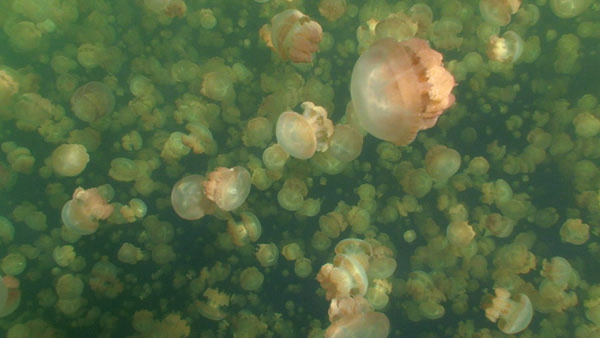Scientists found that the jellyfish also stirred the ocean as strongly as the tide or the wind. Their research also found that the shape of jellyfish affects their ability to mix.
Until now, oceanographers have still argued that the tiny marine creatures such as jellyfish can play an important role in mixing ocean water layers on a large scale. This argument is based on the evidence that any tail-swing from fish is not effective because of the viscosity of ocean water. (In fact, this characteristic in honey is very high compared to water).
But in the new study published in Nature's July 30 issue, the blending mechanism was first revealed by Charles Darwin's grandson. This mechanism is in fact reinforced by the ocean's sticky characteristics, making the small creatures of the ocean a major factor in mixing seawater layers.
John Dabiri - assistant professor of aeronautics and biotechnology at Caltech - said: 'We have been studying swimming species for a relatively long time. What we often expect is how the ocean - based on currents, temperatures, and chemical properties - affects organisms. But more and more signs that the opposite role of organisms is equally important. We are looking at how species, through swimming, have an impact on the ocean environment. '

Scientists studied the motion of the liquid caused by Mastigias in the Palau jellyfish tank.(Photo: K.Katija / J.Dabiri)
Eventually, billions of small and jellyfish migrate hundreds of meters from the depths of the ocean to the surface every day - where they feed. With such a dense bunch of creatures swimming through the world's oceans, if they really mix the ocean's water layers, this effect is really big.
Dabiri said: 'The number of these small creatures is huge. Globally, the energy they spend in the process is equivalent to one billion watts of electricity - on par with wind and tidal energy. '
The creatures stirred the ocean
Dabiri and Kakani graduate student Katija at Caltech studied jellyfish through computer simulations and field studies in Lake Palau in the Pacific Ocean.
In their actual experiment, the researchers sprayed the light droplets into the water in front of the jellyfish Mastigias and then observed what happened when the jellyfish swam through the stained water. Instead of being left behind, the stained water moves with that swimming creature.
They think that when the jellyfish swims, it pushes water aside and creates a high pressure area in front of it. The area behind the jellyfish becomes a low pressure area. So water rushed in the back to fill that low pressure vacuum. As a result, the jellyfish 'pulls' the water along during swimming.

Researchers spray ink into the water and observe the images of jellyfish swimming through the squid.They find the jellyfish carrying the whole country after them (the red vortices slightly behind the jellyfish).(Photo: K.Katija / J.Dabiri)
Katija said: 'The interesting thing about these jellyfish is that they have a great variety in body size'.
That difference can affect the amount of water entrapped in jellyfish. For example, the moon jellyfish (commonly found in aquariums) has a small disc-shaped body, which can carry a lot of water. But other jellyfish with a bullet image can only carry smaller volumes of water.
Global impact
Ocean mixing has even more significance.
If ocean water is not mixed, the ocean surface will lack nutrients because food will be consumed immediately. Meanwhile the ocean floor is depleted of oxygen. According to Katija, 'with this mechanism, through disturbance, organisms can bring nutrient-rich water to poor nutrient areas, while pulling oxygen-rich water to the oxygen-poor regions'.
On a larger scale, organisms that work to mix water layers can affect the circulation of the ocean, which affects the climate of the Earth.
According to Dabiri and Katija, such mixing effects should be incorporated into global circulating ocean models.
 Animal 'suffering' after hibernation
Animal 'suffering' after hibernation Why do goats climb well?
Why do goats climb well? Scientists were surprised to see chimpanzees eating turtles
Scientists were surprised to see chimpanzees eating turtles Giant catfish died deadly due to drought in Thailand
Giant catfish died deadly due to drought in Thailand Shocking discovery about the Earth's 'tail'
Shocking discovery about the Earth's 'tail'  Top 10 Unbelievable Ways Animals Survive in Dangerous Environments
Top 10 Unbelievable Ways Animals Survive in Dangerous Environments  Mysterious wonders of the world
Mysterious wonders of the world  The largest animals that lived in the desert, still exist today
The largest animals that lived in the desert, still exist today  Why can submarines dive and surface?
Why can submarines dive and surface?  2,000-year-old Mayan invention could save us
2,000-year-old Mayan invention could save us 